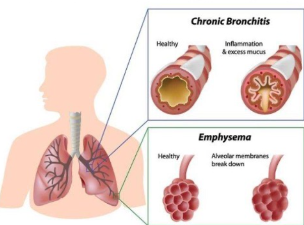Chronic obstructive pulmonary disease (COPD) is a chronic airway inflammatory disease characterized by persistent airflow obstruction, also known as the "silent killer".
Chronic respiratory diseases, led by COPD, have been listed as the world's "four major chronic diseases" by the World Health Organization along with cardiovascular and cerebrovascular diseases, malignant tumors, diabetes and metabolic diseases.

Chronic obstructive pulmonary disease (COPD) is a chronic airway inflammatory disease characterized by persistent airflow obstruction, also known as the "silent killer".
Chronic respiratory diseases, led by COPD, have been listed as the world's "four major chronic diseases" by the World Health Organization along with cardiovascular and cerebrovascular diseases, malignant tumors, diabetes and metabolic diseases.

What are the symptoms of COPD? How to identify it?
The main symptoms of COPD include cough, sputum, and dyspnea. COPD is insidious and the early symptoms are atypical. By the time there are obvious symptoms, the patient's condition is often quite serious. In severe cases, it can further develop into chronic cor pulmonale and respiratory failure. Therefore, if the following situations occur, be alert to COPD:
Coughing accompanied by wheezing, and lasting for more than two months;
Any form of long-term sputum needs to be considered whether it has COPD, especially for smokers, do not ignore persistent coughing and sputum;
If you feel shortness of breath after strenuous activities, you should consider COPD;
During non-strenuous activities, persistent dyspnea should be taken seriously.
Relevant experts suggest that pulmonary function tests are an important means of diagnosing chronic respiratory diseases such as chronic obstructive pulmonary disease. It is recommended that people aged 40 and above or those at high risk of chronic respiratory diseases should have their pulmonary function checked once a year.
Are COPD the same as asthma and emphysema?
COPD is closely related to respiratory diseases such as asthma, and the symptoms are somewhat similar. Many people believe that COPD is the same as asthma, emphysema, etc. Is this true?
COPD is often mistaken for similar diseases such as asthma, emphysema, and chronic bronchitis, but COPD mainly emphasizes airflow limitation, that is, symptoms such as shortness of breath after activity, decreased activity endurance, and labored breathing.
Chronic bronchitis is mainly characterized by coughing and expectation. If the cough accumulates for more than 3 months a year and lasts for more than 2 consecutive years, it can be diagnosed.
Emphysema mainly emphasizes changes in lung morphology, including air cavity expansion and tracheal structure destruction.
Similar to COPD, asthma is also a disease with airflow limitation, but the airflow limitation of asthma is obviously reversible, and the patient is basically normal when there is no attack, which is different from COPD.
What factors are likely to cause COPD?
The risk factors of COPD mainly include smoking, air pollution, occupational exposure, etc. Among them, smoking is the most important risk factor for COPD. At present, it is generally recognized that smoking is the biggest risk factor for COPD, and the greater the amount of smoking, the longer the smoking period, and the younger the age of starting smoking, the higher the risk of COPD. Statistics show that 60%~70% of COPD patients are smokers, and about 10%~15% of smokers will suffer from COPD.
The most common cause of COPD is smoking. The prevalence of chronic bronchitis in smokers is two to eight times higher than that in non-smokers. The longer the smoking age and the more cigarettes smoked, the higher the incidence of lung disease. Tobacco contains chemicals such as tar, nicotine and tar, which can cause the cells and cilia of the upper airway epithelium to proliferate and hypertrophy the goblet cells of the bronchial mucosa, increase secretion, and reduce the purification capacity. It can also increase the production of free radicals, destroy the elastic fibers of the lungs, and induce the formation of emphysema. Therefore, smoking has no benefits but only harms, and smokers should quit smoking as soon as possible.


